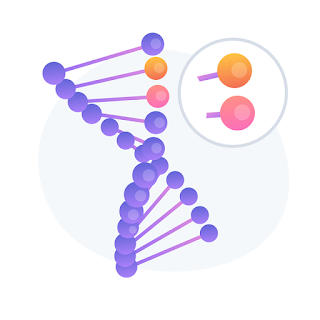DNA Changes and Your Health || BioAro
Almost all of the body's cells contain deoxyribonucleic acid (DNA). Each person's genetic makeup gives them their individuality. DNA contains the instructions necessary for all life to develop, grow, reproduce, and function.
Not only does DNA exist in almost every cell in the body, but if unravelled and stretched end-to-end, a single cell's DNA would measure over 6.5 feet (ft) long.
What is DNA?
The genetic code for every individual is contained in a lengthy molecule called DNA. It contains the instructions required to assemble the proteins required for proper body operation.
About half of a child's DNA comes from the mother and half from the father as parents pass on DNA instructions to their offspring.
How is the DNA organised?
DNA is a two-stranded molecule that has the appearance of being twisted, giving it a distinctive structure known as the double helix.
The two strands are each made up of a substantial number of nucleotides. These are the DNA's basic building blocks, and they consist of a deoxyribose sugar molecule with five carbons and a nitrogen-containing region, along with a phosphate molecule.
There are four different categories of nitrogen-containing regions known as bases, including,
● adenine (A)
● cytosine (C)
● guanine (G)
● thymine (T)
The genetic code, which contains the instructions for life, is made up of the order of these four bases.
The bases of the two DNA strands are bonded together to form a ladder-like structure. The "rungs" of the ladder are made by A sticking to T and G sticking to C. The sugar and phosphate groups help the ladder's length to develop.
What is gene?
A gene is any segment of DNA that codes for a particular protein. For instance, one gene produces the insulin protein, which functions as a hormone to help regulate blood sugar levels. There are thought to be 30,000 genes in humans, although exact numbers are unknown.
It is estimated that only 1% of DNA is made up of genes that code for proteins. The remaining 99% of DNA, whose purpose is less well understood, is thought to have a role in controlling transcription and translation.
The largest chromosome, chromosome 1, has about 2,800 genes . With about 750 genes, chromosome 22 is the smallest.
How does DNA function?
The majority of DNA is found in cell nuclei, whereas a small amount is also found in mitochondria, the powerhouses of the cell.
Human DNA must be packaged extremely carefully since the nuclei are so little and there is so much of it.
DNA strands coil, loop, and wrap around histone proteins. DNA is referred to as chromatin when it is curled up like this.
Chromosomes are structures made of chromatin that have undergone further condensing through a supercoiling process. The well-known "X" shape of these chromosomes is formed.
One DNA molecule can be found on each chromosome. The total number of chromosomes in humans is 46, or 23 pairs. There are different numbers for other species. Fruit flies, for instance, have 8 chromosomes, but pigeons have 80.
Protein Creation:
There are two main processes for genes to produce a protein, including:
● DNA code is duplicated into messenger RNA during transcription (mRNA). While RNA is a single-stranded version of DNA, it is a copy of DNA. The absence of the nucleotide thymine in RNA is another distinction (T). Uracil (U) substitutes thymine in RNA (T).
● By using transfer RNA, the mRNA is translated into amino acids (tRNA).
mRNA contains codons, which are three-letter segments that contain information about a specific amino acid. A distinct amino acid or protein building component is encoded by each codon. For instance, the amino acid valine is coded for by the codon GUG.
The potential amino acids range from 20.
Telomeres
Telomeres, which are found at the end of chromosomes, are areas of repeating nucleotides.
They guard against harm or fusion with other chromosomes to the ends of the chromosome.
The plastic tips on shoelaces that prevent fraying are analogous to them, according to scientists.
This protective area shrinks gradually as a person ages. The length of the telomere decreases with each cell division and DNA replication.
Different DNA Alterations:
DNA alterations can take many different forms, including:
● the replacement of a single base letter in the DNA with another (substitution)
● the insertion or deletion of one or more base letters from DNA
● two or more DNA base letters that have been flipped (inversion)
● one or more DNA base letters are duplicated (duplication)
● the transfer of one or more DNA bases between different locations in the genome (translocation)
Except for identical twins, your genome sequence is unique compared to everyone else's. These variations result from alterations in the DNA, or mutations. Even while just a few new variants appear each generation, the majority of the variants in your genome are inherited. Specific instructions contained in a gene are impacted by some DNA alterations.
A substitution change is deemed a frequent variant when it occurs in more than 1% of the population. Also known as single nucleotide polymorphisms, these (SNPs).
Our genomes also contain portions of DNA bases that are frequently duplicated numerous times. Each person will likely receive a different quantity of copies. Copy number variations are the name for these alterations (CNVs). Once more, these might or might not be significant.
Genetic Propensity for Common or Complex Illness:
Common ailments like heart disease, type II diabetes, malignancies, glaucoma, and arthritis may have hereditary influences, according to research. Contrary to inherited genetic illnesses, these common diseases have a more complicated aetiology. To cause the health problem, they frequently need numerous combinations of DNA changes, lifestyle modifications, and environmental exposures. Additionally, each person will have a unique set of risk factors (genetic, environmental, and behavioural) that must be present for the disease to manifest itself.
GET MORE INFORMATION :- https://bioaro.com/
FOLLOW US
Facebook :- https://www.facebook.com/BioAroinc/
Twitter :- https://twitter.com/bioaroinc
LinkedIn :- https://www.linkedin.com/company/bioaroinc





Comments
Post a Comment